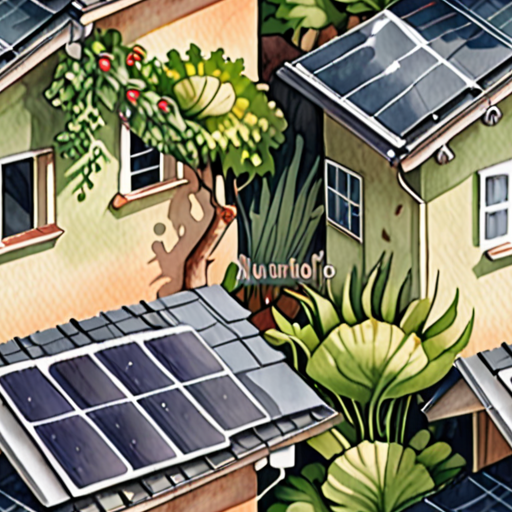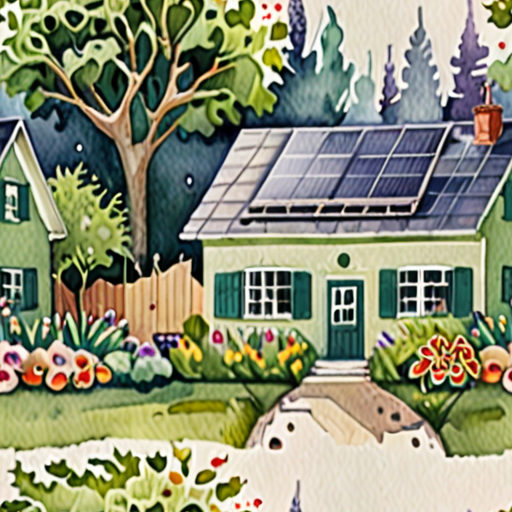As individuals, our daily choices significantly impact the environment, making it essential to adopt sustainable practices in our homes to reduce our ecological footprint. With the increasing awareness about climate change and environmental degradation, many people are seeking ways to live more sustainably, but often find themselves overwhelmed by the sheer amount of information available. In this article, we will explore simple and effective sustainable household tips, providing readers with actionable advice on how to incorporate eco-friendly habits into their daily lives.

Ways to be Sustainable at Home
I’m passionate about making my home more sustainable and eco-friendly, and I’d love to share some tips with you.
- Reduce Energy Consumption: One simple way to start is by reducing energy consumption. This can be achieved by switching to energy-efficient light bulbs, turning off lights and electronics when not in use, and adjusting your thermostat to use less energy for heating and cooling.
- Conserve Water: Conserving water is essential for our planet’s health. Take shorter showers, fix leaks, and install low-flow fixtures to save water.
- Recycle and Compost: Recycling and composting are crucial for reducing waste and creating nutrient-rich soil for gardening. Make sure to recycle paper, plastic, glass, and metal, and compost food scraps and yard trimmings.
- Use Eco-Friendly Cleaning Products: Many cleaning products contain harsh chemicals that harm the environment. Switch to eco-friendly cleaning products or make your own using natural ingredients like baking soda and vinegar.
- Grow Your Own Food: Growing your own food reduces carbon emissions from transportation and supports local ecosystems. Start a small garden or even just a few herbs on your windowsill to get started.
- Use Public Transportation or Walk/Bike: Using public transportation, walking, or biking reduces air pollution and greenhouse gas emissions. Consider carpooling or using ride-sharing services for longer trips.
- Buy Local and Seasonal: Buying local and seasonal produce reduces carbon emissions from transportation and supports local farmers. Visit your local farmer’s market or join a community-supported agriculture program to get started.
- Reduce Paper Waste: Reduce paper waste by switching to digital documents, bills, and receipts. Use reusable bags and containers for grocery shopping and takeout.
- Upcycle and Repurpose: Get creative and find new uses for old items. Upcycle furniture, turn old t-shirts into reusable bags, and repurpose jars for storage.
- Support Renewable Energy: Support renewable energy by investing in solar panels or wind turbines for your home. Consider purchasing renewable energy credits to support clean energy projects.
- Get Involved in Your Community: Join local environmental groups, participate in clean-up events, and advocate for policies that support sustainability. Every small action counts!
Additional Tips:
Some other ways to live sustainably at home include:
- Insulating Your Home: Proper insulation can reduce heat loss and save energy.
- Using Energy-Efficient Appliances: Replace old appliances with energy-efficient ones to reduce energy consumption.
- Planting Trees and Flowers: Planting trees and flowers can help purify the air and reduce stress.
- Reducing Food Waste: Plan meals, shop from local farms, and compost food scraps to reduce waste.
- Using Natural Pest Control: Use natural pest control methods like diatomaceous earth and neem oil to reduce chemical use.
Getting Started:
Remember, every small step counts! Start with what feels manageable and gradually work your way towards a more sustainable lifestyle. Share your progress with friends and family to stay motivated and inspired.
The 5 Cs of Sustainability
At Pyrolysium, we believe that achieving a sustainable future requires a holistic approach that encompasses various aspects of our lives.
- Clean
- Community
- Culture
- Care
- Corporate Governance
We strive to minimize our ecological footprint by adopting clean energy sources, reducing waste, and promoting environmentally friendly practices.
Our commitment to clean energy includes investing in renewable sources like solar and wind power, which helps reduce greenhouse gas emissions and mitigate climate change.
In addition, we promote sustainable consumption patterns by encouraging our community to choose products with minimal packaging, buy second-hand items, and support local businesses that share our values.
This approach not only benefits the environment but also contributes to a healthier and more resilient community.
We recognize the importance of building strong relationships within our community to drive positive change.
By fostering connections among individuals, organizations, and businesses, we can leverage collective knowledge, skills, and resources to tackle complex sustainability challenges.
At Pyrolysium, we engage with local stakeholders through workshops, webinars, and social media platforms to educate and inspire others about sustainable living and eco-friendly technologies.
Through these efforts, we aim to empower individuals and communities to take ownership of their sustainability journey and become agents of positive change.
We believe that culture plays a vital role in shaping our values, behaviors, and attitudes toward sustainability.
By promoting a culture of sustainability, we encourage individuals to adopt environmentally conscious habits, appreciate the beauty of nature, and respect the interconnectedness of human and natural systems.
At Pyrolysium, we celebrate cultural diversity and incorporate traditional knowledge and practices into our sustainability initiatives, recognizing the richness and resilience of indigenous cultures.
By embracing cultural differences and promoting cross-cultural understanding, we can foster a global community that values and protects the planet’s biodiversity.
We prioritize care for the well-being of people and the planet, acknowledging that sustainability is deeply intertwined with social justice and human rights.
At Pyrolysium, we advocate for policies and practices that protect vulnerable populations, promote equitable access to resources, and ensure that everyone has the opportunity to thrive in a sustainable world.
We also recognize the importance of mental health and well-being in the face of climate change and environmental degradation.
By prioritizing care and compassion, we can build a more resilient and empathetic society that supports the health and happiness of all individuals.
We believe that effective corporate governance is essential for driving sustainability and responsible business practices.
At Pyrolysium, we adhere to transparent and accountable governance principles, ensuring that our decision-making processes prioritize long-term sustainability goals over short-term profits.
We also engage with stakeholders to gather feedback and input on our sustainability initiatives, recognizing that collaboration and inclusivity are critical components of successful corporate governance.
By prioritizing corporate governance, we can create a more trustworthy and responsible business ecosystem that supports the well-being of people and the planet.

How Can Households Be More Sustainable?
As someone who is passionate about sustainable living and eco-friendly technologies, I believe that making small changes in our daily lives can have a significant impact on reducing our environmental footprint.
- Reduce, Reuse, Recycle
- Conserve Energy and Water
- Eat Sustainably
- Get Involved in Your Community
One of the simplest ways to live sustainably is to reduce our consumption of single-use plastics, reuse items whenever possible, and recycle as much as we can. By doing so, we can significantly reduce the amount of waste that ends up in landfills and oceans.
Another important aspect of sustainable living is conserving energy and water. Simple actions like turning off lights and electronics when not in use, taking shorter showers, and fixing leaks can make a big difference in reducing our energy and water consumption.
Eating sustainably is also crucial for reducing our environmental impact. This includes choosing locally sourced and seasonal foods, reducing meat consumption, and composting food waste.
Finally, getting involved in your community can be a great way to promote sustainability. Join local initiatives, participate in clean-up events, and advocate for policies that support sustainable living.
Pyrolysium’s Approach to Sustainability
At Pyrolysium, we’re committed to educating and inspiring people about sustainable living and eco-friendly technologies. Our mission is to raise awareness about the importance of reducing waste and conserving resources, and to provide practical insights and actionable steps for those passionate about environmental conservation.
Competitors in the Industry
There are several organizations and companies that share our passion for sustainability and are working towards similar goals. Some notable examples include TerraCycle, which specializes in recycling hard-to-recycle materials, and the Ellen MacArthur Foundation, which promotes circular economy principles.
Practical Steps to Take Today
So what can you do today to start living more sustainably? Here are a few simple steps:
- Start a compost bin or pile to turn food scraps into nutrient-rich soil.
- Invest in energy-efficient appliances and light bulbs.
- Choose products with minimal packaging and made from sustainable materials.
- Support local farmers and artisans who prioritize sustainability.
Conclusion
Sustainability is a journey, not a destination. By making small changes in our daily lives and staying informed about the latest developments in sustainable living, we can work together to create a more environmentally conscious world.

7 Ways We Can Live More Sustainably
We believe that living sustainably is essential for our planet’s future, which is why we’re committed to helping you make environmentally conscious choices.
-
Reduce Your Energy Consumption
One simple way to live more sustainably is to reduce your energy consumption. Start by switching to energy-efficient light bulbs, turning off lights and electronics when not in use, and adjusting your thermostat to use less energy for heating and cooling.
-
Conserve Water
Water is a precious resource, and conserving it is crucial for our planet’s health. Take shorter showers, fix leaks, and install low-flow fixtures to reduce your water usage.
-
Use Public Transportation or Carpool
Transportation is a significant contributor to greenhouse gas emissions, so using public transportation or carpooling is a great way to reduce your carbon footprint. Consider using a bike or walking for shorter trips.
-
Recycle and Compost
Recycling and composting are essential for reducing waste and conserving natural resources. Make sure to recycle paper, plastic, glass, and metal, and compost food scraps and yard waste.
-
Eat Sustainably
Your diet has a significant impact on the environment, so choosing sustainable food options is crucial. Opt for locally sourced, organic produce, and choose plant-based meals to reduce your carbon footprint.
-
Use Eco-Friendly Products
The products we use every day can have a significant impact on the environment. Choose eco-friendly cleaning products, personal care items, and household goods to reduce your chemical usage.
-
Support Renewable Energy
Renewable energy sources like solar and wind power are becoming increasingly important for reducing our reliance on fossil fuels. Consider investing in solar panels or supporting renewable energy projects in your community.
By implementing these simple changes, you can significantly reduce your environmental impact and contribute to a more sustainable future.
Living 100 Sustainably
As someone passionate about reducing my environmental footprint, I’ve learned that living 100% sustainably requires a holistic approach that encompasses every aspect of our lives.
-
Reduce Consumption
One of the most effective ways to live sustainably is to consume less. This means adopting a minimalist lifestyle, buying only what we need, and avoiding single-use plastics.
-
Reuse and Repurpose
Reusing and repurposing items reduces waste and conserves resources. Get creative with old items, turn them into something new, and give them a second life.
-
Borrow and Share
Borrowing and sharing items with friends and family reduces consumption and promotes community building. Consider swapping clothes, tools, or books with others.
-
Buy Second-Hand
Buying second-hand items reduces waste and supports sustainable consumption. Thrift stores, online marketplaces, and garage sales offer a treasure trove of gently used goods.
-
Recycle and Compost
Recycling and composting are essential for managing waste and reducing landfill contributions. Make sure to recycle paper, plastic, glass, and metal, and compost food scraps and yard trimmings.
-
Sustainable Shopping
When shopping, choose products made from sustainable materials, produced locally, and packaged minimally. Support companies that prioritize sustainability and transparency.
-
Eco-Friendly Transportation
Transitioning to eco-friendly transportation options like walking, cycling, carpooling, or using public transport reduces carbon emissions and promotes a healthier environment.
-
Energy Efficiency
Optimizing energy efficiency in our homes and workplaces through LED lighting, insulation, and renewable energy sources reduces energy consumption and greenhouse gas emissions.
-
Water Conservation
Conserving water is crucial for sustainable living. Fix leaks, install low-flow fixtures, and harvest rainwater to reduce water waste and protect this precious resource.
-
Sustainable Food Systems
Adopting sustainable food systems involves choosing locally sourced, organic, and seasonal produce, reducing meat consumption, and supporting regenerative agriculture.
-
Community Engagement
Building a supportive community around sustainable living encourages collective action and fosters a sense of responsibility towards the planet.
By incorporating these habits into daily life, we can significantly reduce our ecological footprint and contribute to a more sustainable future.

What are the Three Pillars of Sustainability?
The concept of sustainability has become increasingly important in today’s world, and understanding its core principles is crucial for making informed decisions about our planet’s future.
- Environmental Sustainability
- Reducing greenhouse gas emissions through renewable energy sources and energy-efficient practices
- Conserving water resources through efficient use and recycling
- Protecting biodiversity by preserving natural habitats and reducing pollution
- Social Sustainability
- Fostering inclusive and equitable communities through education and economic opportunities
- Addressing social issues such as poverty, inequality, and access to healthcare
- Promoting cultural diversity and heritage preservation
- Economic Sustainability
- Investing in sustainable infrastructure and technology
- Diversifying economies to reduce dependence on fossil fuels
- Encouraging sustainable consumption patterns and reducing waste
Environmental sustainability refers to the responsible management of natural resources to minimize harm to the environment and preserve ecosystems for future generations.
Social sustainability focuses on ensuring that human needs are met while promoting social justice and equality.
Economic sustainability involves managing financial resources in a way that ensures long-term viability and stability.
In conclusion, the three pillars of sustainability – environmental, social, and economic – are interconnected and equally important for achieving a sustainable future.

0 Comments